|
|
|
Sort Order |
|
|
|
Items / Page
|
|
|
|
|
|
|
| Srl | Item |
| 1 |
ID:
150715
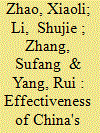

|
|
|
|
|
| Summary/Abstract |
Along with China's rapid industrialization and urbanization, challenges in reducing pollution and CO2 emissions are increasing. One of the major approaches to coordinate economic growth and environmental protection is to substitute coal-fired power with renewable energy. Since 2003, in order to promote wind power development, China has put in place many support policies which fall into either price policy category or non-price policy category. By using a variable intercept and mixed regression model with provincial panel data during 2001–2013, we analyzed the impacts of both categories on the increase of installed capacity in areas with different wind resources. We found that price policy and two non-price policies had positive impacts on the increase of wind power installation, price policy played a greater role than non-price policy did in promoting wind power development, and price policy was more effective in areas with poor wind resources, whilst non- price policy was more effective in areas with rich wind resources. Built on these findings, conclusions and policy recommendations are provided at the end of the paper.
|
|
|
|
|
|
|
|
|
|
|
|
|
|
|
|
| 2 |
ID:
128452
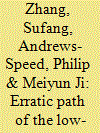

|
|
|
|
|
| Publication |
2014.
|
| Summary/Abstract |
The last twenty years have seen the growth of both solar PV manufacturing capacity and deployment in China, yet this growth has followed a very erratic path. This study applies the concept of socio-technical regime to identify factors which have made this path so erratic. We examine four stages in China's solar PV policy from mid-1990s to 2013 and show that each is characterized by different combinations of policy program. These changes in government policy and in the resultant trajectory of the solar PV sector are attributed to three main sets of variables. The most important of these are events which shape the wider policy priorities of China's government. Secondary factors include the government's poor management of the policy interaction between the domestic solar PV manufacturing industry and the deployment of solar PV across the country, as well as policy learning within government. The general lesson from this study is that the development path of a single element of a national strategy for the low-carbon transition is likely to be erratic, subject as it is to a range of political and economic forces, and to experimentation and learning.
|
|
|
|
|
|
|
|
|
|
|
|
|
|
|
|
| 3 |
ID:
150704
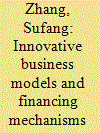

|
|
|
|
|
| Summary/Abstract |
The Chinese government has in recent years put in place a large number of incentive policies for distributed solar PV (DSPV). However, some of these policies have not been well performed due to many constraints, particularly the lack of innovative business models and financing mechanisms. This paper looks into this issue through the approach of combining literature review and interactive research, including interactions with managers from China's policy and commercial banks and PV projects. A comprehensive literature review on DSPV business models and financing mechanisms are firstly reviewed. Then the rapid evolving business models and financing mechanisms in the United States are examined, which provides some insights for China. Subsequent to this, the existing innovative business models and financing mechanisms for DSPV deployment in China and challenges facing them are discussed. Built on this discussion, policy recommendations are provided at the end of the paper. This study provides some insights for renewable energy policy makers in China as well as in other countries.
|
|
|
|
|
|
|
|
|
|
|
|
|
|
|
|
| 4 |
ID:
125724
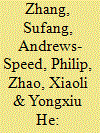

|
|
|
|
|
| Publication |
2013.
|
| Summary/Abstract |
This paper analyzes China's policy approach to renewable energies and assesses how effectively China has met the ideal of appropriate interactions between renewable energy policy and renewable energy industrial policy. First we briefly discuss the interactions between these two policies. Then we outline China's key renewable energy and renewable industrial policies and find that China's government has well recognized the need for this policy interaction. After that, we study the achievements and problems in China's wind and solar PV sector during 2005-2012 and argue that China's policy approach to renewable energies has placed priority first on developing a renewable energy manufacturing industry and only second on renewable energy itself, and it has not effectively met the ideal of appropriate interactions between renewable energy policy and renewable energy industrial policy. Lastly, we make an in-depth analysis of the three ideas underlying this policy approach, that is, the green development idea, the low-carbon leadership idea and indigenous innovation idea. We conclude that Chinas' policy approach to renewable energies needs to enhance the interactions between renewable energy policy and renewable energy industrial policy. The paper contributes to a deeper understanding of China's policy strategy toward renewable energies.
|
|
|
|
|
|
|
|
|
|
|
|
|
|
|
|
| 5 |
ID:
121289
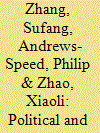

|
|
|
|
|
| Publication |
2013.
|
| Summary/Abstract |
This paper identifies and explains how political and institutional factors have determined the relative successes and failures of China's wind power policy over the period 2005-2011. It finds that China has made significant progress in pursuing its wind power policy in terms of cumulative installed capacity, wind turbine manufacturing industry development and wind turbine cost, and argues that these achievements can be attributed to the political motives and institutional arrangements of the Chinese government as well as to institutional changes. On the other hand, the paper finds that there are two prominent policy failures, namely the low proportion of grid-connected capacity and the rising trend of wind turbine incidents. These have undermined the efficiency and effectiveness of China's wind power program. The paper holds that the institutional sources for the first policy failure lies in the preference for setting wind power development targets in terms of installed capacity rather than generation and in coordination problems while the second policy failure lies in the lack of state technical codes for wind power integration and the unfair competition from the large state-owned power companies. The paper contributes to the academic literature on the political and institutional roles in China's wind power policy.
|
|
|
|
|
|
|
|
|
|
|
|
|
|
|
|
| 6 |
ID:
126563


|
|
|
|
|
| Publication |
2013.
|
| Summary/Abstract |
China's wind power is in an embarrassing state. Along with its dramatic development since 2005, its curtailment ratio has been rising. Although this could be attributed to both physical and institutional factors, it is the institutional obstacles, mainly resulting from the adjustment difficulties of interests distribution, that have exercised a greater impact. The stakeholders relating to wind power integration are thermal power companies, grid companies and local governments. The extent to which wind power deployment affects these vested interests determines the core institutional obstacles to be addressed. Mainly based on quantitative and case analyses, we argue that currently wind deployment in China has a little impact on the interests of thermal companies, moderate impact on the interests of grid companies and great impact on local governments. We recommend that it is crucial to elevate the role of environmental protection and renewable energy increase while de-emphasize the role of economic growth in the evaluation of local governments' performance, as well as provide incentives for grid companies to attend more to their social responsibilities rather than their scale expansion and revenue growth.
|
|
|
|
|
|
|
|
|
|
|
|
|
|
|
|
|
|
|
|
|